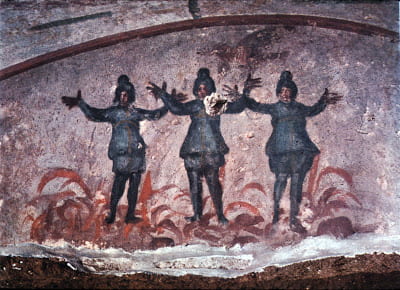By Clare Kemmerer, Dannie Briggs, Kaedy Puckett, and Maya Ordonez
Part I:
“History is what hurts” remarked Fredric Jameson; Jeffrey Hamburger, responding, asks “what could be more natural than pain?”. Pain, in the Middle Ages, was gratuitously enacted and engaged upon; physical anguish was invoked in everything from grotesque legal punishments to depictions of Hell, from monastic pious practices to gruesome artworks. Artworks from the Middle Ages present pain in a manner of “overkill”, creating scenarios so graphic that they are beyond the capacity of the ordinary imagination. Bodies are pierced with arrows, flayed and roast; the damned feast on each other’s bodies, their bodies contorted in flame. Medieval descriptions of pain–visual and textual–“present a pantomime of pain the likes of which one could not imagine without their suggestive power”. Pain is the property of imagination; the thing which is inferred from images and text describing torture.
The author of an Old English adaptation of the Book of Daniel works in this tradition of overkill and imagination, describing in detail the burning of youths at the behest of the Babylonian king. Pain is absent in the language of the author: it is left to the imagination of the reader. Detailed depictions of flame and heat shape the narrative of the men burning in the ovens, but the author conspicuously omits details of agony. Such agony is for the reader to infer: they are witnesses to pain, affected by the words in such a way as to draw them towards simultaneous empathy and revulsion. Pain is thus framed as a pious act of the imagination, an action performed by the reader in response to the bodily experiences that they witness, through sight, reading or hearing. This is in keeping with the landscape of medieval pain and piety, a landscape which invited Christians to empathize with (in prayer and sometimes in action) the suffering of others as a way to draw near to the suffering of Christ. Pain was thus a triangulated action: experienced (sometimes by a fictional body), witnessed by the reader, and recorded by the text or object. The viewer’s pious pain was in turn witnessed by God, as a form of engagement with Christ.
Part 2:
Reading the poem and original text of Daniel in comparison brings to light how the poet changed, in his version, the degrees of heavenly involvement in punishments. There are two main differences in divine punitive intervention. The first instance is in King Nebekinzzar’s exile which is in the bible described as a madness induced by Heaven where “a voice came down from heaven” and prophesied that the King would be “cast thee out from among men… thou shalt eat grass like an ox… till thou know that the most High ruleth in the kingdom of men’ (Daniel 4.29-30)*. Just as the voice from heaven decreed, the King was physically transformed into a wild animal for 7 years after which his “shape returned to me” and he renounces his pagan beliefs(Daniel 4.34)*. In contrast, in the poem Nebekenezer seems to go mad of his own accord- he ‘became seized with madness and departed in flight’. After his 7 years he inexpliably ‘returned from his mad mind’ with a Christian disposition (Anlezark 289). Interestingly, the bible was written so that the Nabakanesar takes up Christianity as his human body returns to him, which creates the impression that his prior pagan beliefs were sub-human. In the poem, the direct involvement of heaven in spelling out the King’s physical punishment is removed, and instead replaced with an unexplained spell of madness and surprising recovery to Christianity. The poem’s sequence of events, rather than highlighting the animality of paganness instead highlights how surprising and “miracle”-like that Nebuchenesar’s de-paganization is (Anlezark 291). Another instance of difference in divine involvement in punishment occurs in the writing on the wall that acts as testimony against King Baltazar. In the Bible, a disjointed hand writes on the wall (Daniel 5.6) but in the poem an “angel of the Lord allows his hand to come into the high hall, then wrote enigmatic words on the wall” (Anlezark 295). What do you make of why the poet chose to insert divine influence here?
Part 3:
Painful Witness: a sonnet
How many are the suffering of such pain,
Whose witness is in faith or testament;
In corrupt hands do rise up, or refrain
And in fear do succumb to man’s judgement?
Though Kings of Babylon seek power great
Consigning those whose faith is not in each
Some lose faith to brutality in wait
While others still the Lord they do beseech
And gruesome trials face the ones who know
That Presence which omnisciently decides
So Daniel too must true belief he show
Salvation is what faith in God provides
But feel not lions teeth or flame of fire
For spared is he by faith, and God’s desire
Citations
Image: http://www.newliturgicalmovement.org/2017/12/why-is-this-fresco-of-fiery-furnace-so.html#.XqynJVNKgXo
Anlezark, Daniel. Old Testament Narratives. Harvard University Press, 2011.
*I used the Douay-Rheims Bible found at http://www.drbo.org/chapter/32004.htm
Fredric Jameson. The Political Unconscious: Narrative as a Socially Symbolic Act (Ithaca, NY: Cornell University Press, 1981), 102.
Jeffrey Hamburger. “Overkill, or History That Hurts”, Common Knowledge, 13:2-3 (Duke University Press, 2007), 404-428.
Hostetter, Aaron. “Daniel”, https://anglosaxonpoetry.camden.rutgers.edu/daniel/. Accessed April 1, 2020.
